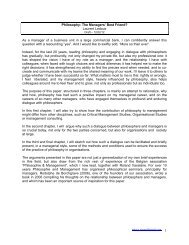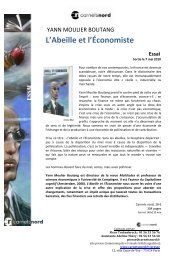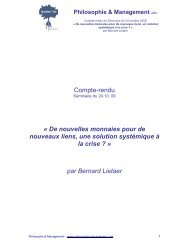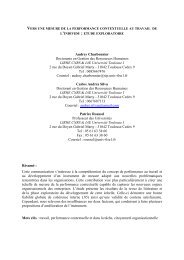The $100 billion question - Signal Lake Venture Fund
The $100 billion question - Signal Lake Venture Fund
The $100 billion question - Signal Lake Venture Fund
Create successful ePaper yourself
Turn your PDF publications into a flip-book with our unique Google optimized e-Paper software.
the relationship is positively sloped, with size and diversity increasing income variability, not<br />
smoothing it.<br />
Charts 6 and 7 look at banks’ experience during the crisis. Size and diversity are plotted against<br />
banks’ write-downs (per unit of assets). Again, if anything, these relationships are positively<br />
sloped, with larger, more diversified banks suffering proportionally greater losses. This is<br />
consistent with evidence from econometric studies of banking conglomerates which has found<br />
that larger banks, if anything, exhibit greater risk due to higher volatility assets and activities. 20<br />
This evidence is no more than illustrative. But it suggests that, in the arm wrestle between<br />
diversification and diversity, the latter appears to have held the upper hand. Bigger and broader<br />
banking does not obviously appear to have been better, at least in a risk sense. In banking, as on<br />
many things, Merton may have had it right.<br />
(b) Robustness<br />
<strong>The</strong> Merton result holds in a world in which investors form judgements based on knowledge of<br />
the distribution of risk. But in complex dynamic systems, the distribution of risk may be lumpy<br />
and non-linear, subject to tipping points and discontinuities. 21 Faced with this, the distribution of<br />
outcomes for the financial system as a whole may well be incalculable. <strong>The</strong> financial system may<br />
operate in an environment of uncertainty, in the Knightian sense, as distinct from risk.<br />
<strong>The</strong>re is a literature on how best to regulate systems in the face of such Knightian uncertainty. 22<br />
It suggests some guideposts for regulation of financial systems. First, keep it simple. Complex<br />
control of a complex system is a recipe for confusion at best, catastrophe at worst. Complex<br />
control adds, not subtracts, from the Knightian uncertainty problem. <strong>The</strong> US constitution is four<br />
pages long. <strong>The</strong> recently-tabled Dodd Bill on US financial sector reform is 1,336 pages long.<br />
Which do you imagine will have the more lasting impact on behaviour.<br />
Second, faced with uncertainty, the best approach is often to choose a strategy which avoids the<br />
extreme tails of the distribution. Technically, economists call this a “minimax” strategy –<br />
minimising the likelihood of the worst outcome. Paranoia can sometimes be an optimal strategy.<br />
This is a principle which engineers took to heart a generation ago. It is especially evident in the<br />
_____________________________________________________________________________<br />
20<br />
De Nicolo (2000).<br />
21<br />
Haldane (2009b).<br />
22<br />
See, for example, Aikman et al (2010).<br />
13
















